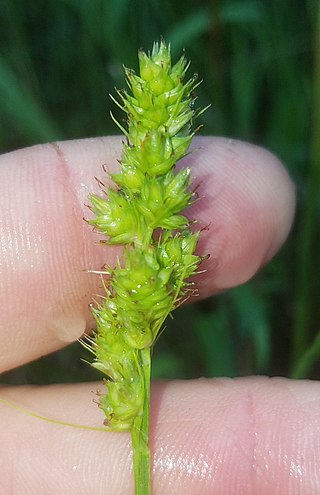
Eriocottidae or Old World spiny-winged moths is a family of insects in the order Lepidoptera whose position relative to other members of the superfamily Tineoidea is currently unknown. There are two subfamilies, Compsocteninae and Eriocottinae.

Quercus austrina, the bastard white oak or bluff oak, is an oak species that is endemic to the southeastern United States from Mississippi to the Carolinas, with a few isolated populations in Arkansas.

Carex austrina, known as southern sedge, is a species of sedge endemic to the southern and central United States.
Aethiopsestis austrina is a moth in the family Drepanidae. It was described by Watson in 1965. It is found in Zimbabwe and South Africa.
Crepidochares is a genus of moths in the family Eriocottidae.
Dacryphanes is a monotypic moth genus in the family Eriocottidae. Its only species, Dacryphanes cyanastra, is found in India. Both the genus and species were first described by Edward Meyrick in 1907.
Tetracladessa is a monotypic moth genus in the family Eriocottidae erected by László Anthony Gozmány and Lajos Vári in 1973. Its sole species, Tetracladessa chalcoxesta, was first described by Edward Meyrick in 1920. It is found in South Africa.
Compsoctena dermatodes is a moth in the family Eriocottidae. It was described by Edward Meyrick in 1914. It is found in South Africa, Tanzania and Zimbabwe.
Compsoctena microctenis is a moth in the family Eriocottidae. It was described by Edward Meyrick in 1914. It is found in South Africa, Tanzania and Zimbabwe.
Compsoctena psammosticha is a moth in the family Eriocottidae. It was described by Edward Meyrick in 1921. It is found in Malawi, South Africa and Zimbabwe.
Compsoctena quassa is a moth in the family Eriocottidae. It was described by Edward Meyrick in 1921. It is found in South Africa, Zambia and Zimbabwe.
Compsoctena agria is a moth in the family Eriocottidae. It was described by Edward Meyrick in 1909. It is found in Gauteng, South Africa.
Compsoctena expers is a moth in the family Eriocottidae. It was described by Edward Meyrick in 1911. It is found in Namibia and Zimbabwe.
Crepidochares colombiae is a moth in the family Eriocottidae. It was described by Donald R. Davis in 1990. It is found in Colombia.
Crepidochares subtigrina is a moth in the family Eriocottidae. It was described by Edward Meyrick in 1922. It is found in Brazil, where it has been recorded only from Amazonas at an area along the Amazon River.
Deuterotinea axiurga is a moth in the family Eriocottidae. It was described by Edward Meyrick in 1922. It is found in Syria.
Deuterotinea palaestinensis is a moth in the family Eriocottidae. It was described by Hans Rebel in 1901. It is found in Israel and Turkey.
Eriocottis pyrocoma is a moth in the family Eriocottidae. It was described by Edward Meyrick in 1891. It is found in Algeria.
Cathalistis secularis is a moth in the family Eriocottidae. It was described by Edward Meyrick in 1918. It is found in South Africa, where it has been recorded from Gauteng.
Eucryptogona trichobathra is a moth in the family Eriocottidae described by Oswald Bertram Lower in 1901. It is found in the Australian state of New South Wales.


